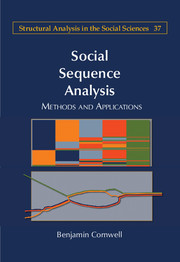Book contents
- Frontmatter
- Contents
- List of Figures
- List of Tables
- Preface
- Acknowledgments
- PART I INTRODUCTION
- PART II THEORETICAL BACKGROUND
- PART III SOCIAL SEQUENCE ANALYSIS CONCEPTS AND TECHNIQUES
- 3 Sequence Analysis Concepts and Data
- 4 Detecting Sequence Structure
- 5 Whole-Sequence Comparison Methods
- PART IV NEW DIRECTIONS IN SOCIAL SEQUENCE ANALYSIS
- PART V CONCLUSIONS
- Appendix A Recent Whole-Sequence Pattern Analyses
- Appendix B Linkage Criteria for Agglomerative Hierarchical Clustering
- References
- Index
- Recent Books in the Series (continued from page iii)
5 - Whole-Sequence Comparison Methods
from PART III - SOCIAL SEQUENCE ANALYSIS CONCEPTS AND TECHNIQUES
Published online by Cambridge University Press: 05 July 2015
- Frontmatter
- Contents
- List of Figures
- List of Tables
- Preface
- Acknowledgments
- PART I INTRODUCTION
- PART II THEORETICAL BACKGROUND
- PART III SOCIAL SEQUENCE ANALYSIS CONCEPTS AND TECHNIQUES
- 3 Sequence Analysis Concepts and Data
- 4 Detecting Sequence Structure
- 5 Whole-Sequence Comparison Methods
- PART IV NEW DIRECTIONS IN SOCIAL SEQUENCE ANALYSIS
- PART V CONCLUSIONS
- Appendix A Recent Whole-Sequence Pattern Analyses
- Appendix B Linkage Criteria for Agglomerative Hierarchical Clustering
- References
- Index
- Recent Books in the Series (continued from page iii)
Summary
So far, this book has presented tools for describing sequences and for quantifying elementary aspects of sequence structure. In many cases, analysts are also interested in describing holistic sequences in terms of types or classes that reflect socially meaningful trajectories or patterns of events that are experienced by subjects. Some sequences are incredibly complex and thus may seem too detailed to allow meaningful interpretation or classification. This chapter shows how this can be done.
The primary task in detecting holistic sequence patterns is to examine how the sequences in the sample are related to each other. This is done through comparisonsof whole sequences to each other, which is an analytic step beyond the techniques that have been presented thus far (which were more focused on the elements within sequences and the transitions between them). Only by doing this can we determine, for example, the extent to which a given subject's or group of subjects' sequences are unique, to what extent they differ from other sequences, and in what way.
The first step in this comparison is to assess the extent to which each pair of sequences are dissimilar, or distant, from each other. There are several ways to compare sequences. By far the most common approach in the social sciences is optimal matching (OM) analysis. This approach stems from similar techniques in molecular biology for analyzing DNA sequences (Sankoff and Kruskal 1983). Although the number of applications that use OM has grown rapidly in recent years, it is has been criticized on both theoretical and methodological grounds (see Levine 2000; Wu 2000). This chapter will present the method and also address the criticisms and problems associated with it. The chapter will then describe recent methodological advances that either improve on or expand on OM, or that sidestep some of its problems altogether by adopting different sequence comparison techniques. This chapter also shows how the results of OM and related sequence comparison techniques can be utilized to identify sequence patterns, which the techniques discussed in Chapters 3 and 4 are not capable of identifying.
- Type
- Chapter
- Information
- Social Sequence AnalysisMethods and Applications, pp. 109 - 152Publisher: Cambridge University PressPrint publication year: 2015



